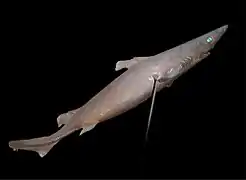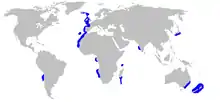Longnose velvet dogfish
The longnose velvet dogfish (Centroselachus crepidater) is a sleeper shark of the family Somniosidae, found circumglobally in southern hemisphere subtropical seas, at depths of between 230 and 1,500 m.[2][3] It reaches a length of 130 cm.[3] It has a diet consisting of predominantly mesopelagic fishes and squids.[4]
| Longnose velvet dogfish | |
|---|---|
 | |
| Scientific classification | |
| Domain: | Eukaryota |
| Kingdom: | Animalia |
| Phylum: | Chordata |
| Class: | Chondrichthyes |
| Order: | Squaliformes |
| Family: | Somniosidae |
| Genus: | Centroselachus Garman, 1913 |
| Species: | C. crepidater |
| Binomial name | |
| Centroselachus crepidater (Barbosa du Bocage & Brito Capello, 1864) | |
 | |
| Range of the longnose velvet dogfish (in blue) | |
Conservation status
The New Zealand Department of Conservation has classified the longnose velvet dogfish as "Not Threatened" with the qualifier "Secure Overseas" under the New Zealand Threat Classification System.[5]
References
Wikimedia Commons has media related to Centroselachus crepidater.
- Finucci, B.; Cheok, J.; Cotton, C.F.; Kulka, D.W.; Neat, F.C.; Pacoureau, N.; Rigby, C.L.; Tanaka, S.; Walker, T.I. (2020). "Centroselachus crepidater". IUCN Red List of Threatened Species. 2020: e.T46864A68615502. doi:10.2305/IUCN.UK.2020-3.RLTS.T46864A68615502.en. Retrieved 19 November 2021.
- Ayling, Tony; Cox, Geoffrey J. (1982). Collins guide to the sea fishes of New Zealand. Auckland [N.Z.]: Collins. ISBN 0002169878. OCLC 9506630.
- Carpenter, Kent E.; Capuli, Estelita Emily (January 2019). "Centroscymnus crepidater (Barbosa du Bocage & de Brito Capello, 1864) Longnose velvet dogfish". Fishbase. Retrieved 18 January 2019.
- Dunn, M., Szabo, A., McVeagh, M., & Smith, P. (2010). The diet of deepwater sharks and the benefits of using DNA identification of prey. Deep-Sea Research Part I-Oceanographic Research Papers, 57(7), 923–930. https://doi.org/10.1016/j.dsr.2010.02.006
- Duffy, Clinton A. J.; Francis, Malcolm; Dunn, M. R.; Finucci, Brit; Ford, Richard; Hitchmough, Rod; Rolfe, Jeremy (2018). Conservation status of New Zealand chondrichthyans (chimaeras, sharks and rays), 2016 (PDF). Wellington, New Zealand: Department of Conservation. p. 9. ISBN 9781988514628. OCLC 1042901090.
| Taxon identifiers |
|---|
This article is issued from Wikipedia. The text is licensed under Creative Commons - Attribution - Sharealike. Additional terms may apply for the media files.
